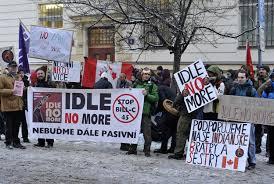Idle no More revived
Indigenous voices denouce police violence against indigenous women and demand that new Prime Minister Justin Trudeau should set up an independent investigation.
- Opinión

Two years ago, there arose in Canada an indigenous movement of a new kind. The protagonists were young women who protested against the infrahuman conditions in which the autochthonous population of this country have to live on the "reserves" and in the poorer districts of many cities. The spark was the hunger strike initiated by Theresa Spence, Chief of the people of Attawapiskat, in the Northern Ontario. For years, her petitions for clean drinking water, decent housing and medical attention were ignored by the authorities of the country. She maintained her strike for several weeks. The media that ridiculed her in the beginning changed their tone when they saw how the protest was amplified. Thousands of demonstrators marched in the whole country, and took as a symbol a Red Feather, the colour of rebellion, and adopted the slogan Idle No More ("an end to passivity"). For the greater part of the non indigenous people of Canada, the movement of the Red Feathers signified an awakening to the hard reality in which the First Nations live today.
On the night of October 22, 2015, there was another shock wave. Twelve Nishabe women from Val d'Or (a mining community in Northwest Quebec) appeared on the public television of Radio Canada (French) denouncing physical and sexual violence that has been inflicted on them by the provincial police (Sûreté du Québec). This time the spark was the disappearance of a native woman, Cindy Ruperthouse, in Val d'Or, in April of 2014. Complaints to the police were of no avail, they were filed without even inquiring among Cindy's friends and acquaintances. The event caught the attention of a group of women investigative journalists in Montreal: For them, Cindy was one of more than 1000 women disappeared and assassinated in Canada over ten years. The journalist Josée Dupuis went to Val d'Or and began to reconstruct the conspiracy of silence which surrounds this disappearance.
She gained the confidence of Cindy's friends and they decided to SPEAK OUT after years and years of silence. Their testimony on public television in a widely popular programme, impacted the whole country. They revealed the horrifying conditions of life for indigenous women who live in this mining town (a situation that is surely repeated in many other places). Many young indigenous women come to the city "looking for a better life" than what they had known on the reserves where poverty is the norm, along with alcoholism and violence. But in the city, there are no jobs for them and they are soon on the streets. Their precarious economic situation and the dominant racism makes them extremely vulnerable, exposed to more of the usual violence. The testimonies of the young women show how the police of the Sûreté du Québec, who should protect them, have become their oppressors. After arbitrary arrests, the patrol car often does not take them to headquarters, but to a forest road where they are aggressed and raped. Those who resist are beaten. An alternative punishment: abandon the rebel in the forest, two hours' walk from the city, with temperatures of thirty below zero! Another recounted how, at 19 years of age, she felt greater security when she saw that they were taking her to police headquarters: but there she was raped, while some of the personnel just looked the other way! Cindy was another victim of a generalized system of abuse, but in her case it ended tragically. Although they said they were afraid that their testimonies would affect their personal safety, the young women exposed the truth to full light.
The journalist's investigation revealed that the Ministry of Justice of the province of Québec had been aware for five months of these complaints against the police . . . and nothing was done until the affair became public. The example came from the top. Prime Minister Stephen Harper, who was in power for almost ten years, always refused to undertake an investigation about the thousands of disappearances that happened (principally in two Western provinces of the country, Alberta and British Columbia), alleging that one "has to let the police do their work". The events of Val d'Or indicate that the police are part of the problem.
The recent shock wave has already produced some results: the Minister of Justice suspended (temporarily) eight policemen denounced by their victims… and she finally had to step down from office. In Val d'Or, hundreds of demonstrators, indigenous and non indigenous marched together against racism and police violence. The Assembly of First Nations of Québec-Labrador, which represents the ten indigenous peoples in the province, convoked an emergency meeting in Val d'Or itself to decide immediate actions. Indigenous voices from the whole country demand that the new Prime Minister Justin Trudeau should finally set up an independent investigation at the national level on the assassinations and disappearances of indigenous women. He had promised this during the electoral campaign.
From one sea to the other, the Red Feathers are rising again!
(Translated for ALAI by Jordan Bishop)
- Pierre Beaucage is an Anthropologist
Montreal, Quebec, Canadá
Del mismo autor
- Idle no More revived 31/10/2015
- Canadá: Revive Idle No More 27/10/2015
- Un panorama de empresas mineras canadienses en México y de la resistencia popular 17/09/2014
- Idle No More (« Se acabó la inacción »). ¿Hacia un invierno indígena en Canadá? 11/01/2013
- Los pueblos indios y campesinos y su lucha por la defensa y el aprovechamiento de los recursos naturales en América Latina 05/06/2007
Mujeres
- Paola Ricaurte 10/03/2022
- Giorgio Trucchi 03/03/2022
- Diana Carolina Alfonso, Mónica Miranda 22/02/2022
- Miguel Pinto Parabá 26/01/2022
- Jo-Marie Burt, Paulo Estrada 12/01/2022
